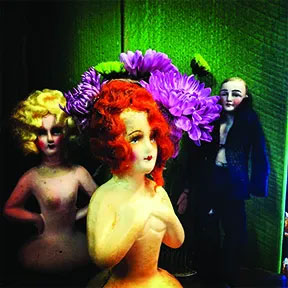Story and photographs by Martha Whitney Butler//
“Where is the rest of her body?” inquired a curious customer. No, they’re not talking about a scene out of a horror movie. They’re asking about one of the most interesting figurines you’ll see in an antique store: half dolls.
Made for a plethora of purposes, this busy lady executed more household tasks than I ever will, and she’s only half the woman! If you haven’t seen one before, I guarantee that you’ll start noticing them now. They’re comprised of everything from fine china to paper-mache and sit atop a variety of creations such as pincushions and lampshades.
These fine ladies were manufactured from the turn of the 20th century until about the early 1930s. Using a mold process, their shapes were cast for increased production. A good way to determine value is by the form and body language of the figurine.
Obviously, if you can see cast lines and seams, she’s not as high in quality. Arms that are cast close to the body suggest a more elementary casting process, while those whose arms are further away or not touching the body are more complicated and more valuable.
A great example of one of these is the Chocolate Lady, a half doll who bears a tray of a chocolate pot and cup. Some of them are extending their arms, and some are carrying baskets or flowers. These are the ones to really look for, but I always suggest buying what you like!
The finer, hand-painted porcelain half dolls come from Germany. While sometimes unmarked, you can usually tell if the doll is German by the quality of the painting and casting. Like most items I write about, Japan also produced several whose craftsmanship is lacking due to mass manufacturing.
The value is largely based on the design and intricacy of the doll itself. If she has an elaborate hairdo or is fashionably dressed, she’s more valuable than her nude counterparts. But for some of us the naughty nude girls that are running around the antique shops topless are way more fun. They’re meant to eventually be clothed by their buyer’s choice in fashion, but some of them never made it to that stage and are conducting themselves in a debatably unbecoming manner.
So what were their jobs? I could name more uses for these dolls than Bubba from Forrest Gump could name shrimp dishes, but I’ll give you a few: They were employed as pincushions, clothing brush handles, lampshades, powder box lids, and anything useful in the home. Imagine them as the predecessor to the crocheted toilet paper cover. It’s basically going to be that with a doll on it.
If you’re lucky enough to own one of the Viennese Chocolate Ladies that were produced by the Goebel porcelain factory as an advertising piece for Walter Baker chocolate, stop in and show her off. I’d love to see one in person. If you have one of these fabulous treasures sitting around the house, make use of her! All you have to do is find something to sew her to, or you could just duct tape her to your gear shifter. Just kidding — well, kind of.


